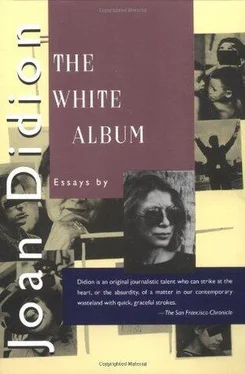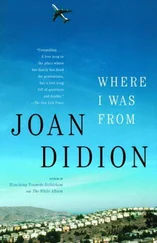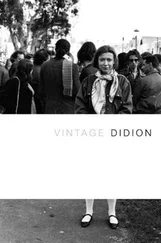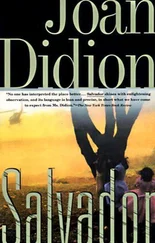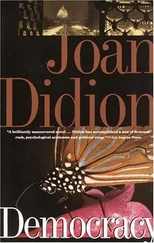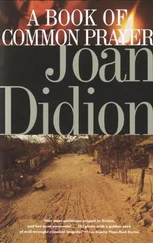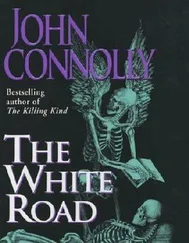At Berkeley in the Fifties no one was surprised by anything at all, a donnée which tended to render discourse less than spirited, and debate nonexistent. The world was by definition imperfect, and so of course was the university. There was some talk even then about IBM cards, but on balance the notion that free education for tens of thousands of people might involve automation did not seem unreasonable. We took it for granted that the Board of Regents would sometimes act wrongly We simply avoided those students rumored to be FBI informers. We were that generation called “silent,” but we were silent neither, as some thought, because we shared the period’s official optimism nor, as others thought, because we feared its official repression. We were silent because the exhilaration of social action seemed to many of us just one more way of escaping the personal, of masking for a while that dread of the meaningless which was man’s fate.
To have assumed that particular fate so early was the peculiarity of my generation. I think now that we were the last generation to identify with adults. That most of us have found adulthood just as morally ambiguous as we expected it to be falls perhaps into the category of prophecies self-fulfilled: I am simply not sure. I am telling you only how it was. The mood of Berkeley in those years was one of mild but chronic “depression,” against which I remember certain small things that seemed to me somehow explications, dazzling in their clarity, of the world I was about to enter: I remember a woman picking daffodils in the rain one day when I was walking in the hills. I remember a teacher who drank too much one night and revealed his fright and bitterness. I remember my real joy at discovering for the first time how language worked, at discovering, for example, that the central line of Heart of Darkness was a postscript. All such images were personal, and the personal was all that most of us expected to find. We would make a separate peace. We would do graduate work I in Middle English, we would go abroad. We would make some money and live on a ranch. We would survive outside history, in a kind of idée fixe referred to always, during the years I spent at Berkeley, as “some little town with a decent beach.”
As it worked out I did not find or even look for the little town with the decent beach. I sat in the large bare apartment in which I lived my junior and senior years (I had lived awhile in a sorority, the Tri Delt house, and had left it, typically, not over any “issue” but because I, the implacable “I,” did not like living with sixty people) and I read Camus and Henry James and I watched a flowering plum come in and out of blossom and at night, most nights, I walked outside and looked up to where the cyclotron and the bevatron glowed on the dark hillside, unspeakable mysteries which engaged me, in the style of my time, only personally. Later I got out of Berkeley and went to New York and later I got out of New York and came to Los Angeles. What I have made for myself is personal, but is not exactly peace. Only one person I knew at Berkeley later discovered an ideology, dealt himself into history, cut himself loose from both his own dread and his own time. A few of the people I knew at Berkeley killed themselves not long after. Another attempted suicide in Mexico and then, in a recovery which seemed in many ways a more advanced derangement, came home and joined the Bank of Americas three-year executive-training program. Most of us live less theatrically, but remain the survivors of a peculiar and inward time. If I could believe that going to a barricade would affect man’s fate in the slightest I would go to that barricade, and quite often I wish that I could, but it would be less than honest to say that I expect to happen upon such a happy ending.
1970
1
in A way it seems the most idiosyncratic of beach communities, twenty-seven miles of coastline with no hotel, no passable restaurant, nothing to attract the traveler’s dollar. It is not a resort. No one “vacations” or “holidays,” as those words are conventionally understood, at Malibu. Its principal residential street, the Pacific Coast Highway, is quite literally a highway, California i, which runs from the Mexican border to the Oregon line and brings Greyhound buses and refrigerated produce trucks and six-teen-wheel gasoline tankers hurtling past the front windows of houses frequently bought and sold for over a million dollars. The water off Malibu is neither as clear nor as tropically colored as the water off La Jolla. The beaches at Malibu are neither as white nor as wide as the beach at Carmel. The hills are scrubby and barren, infested with bikers and rattlesnakes, scarred with cuts and old burns and new R. V. parks. For these and other reasons Malibu tends to astonish and disappoint those who have never before seen it, and yet its very name remains, in the imagination of people all over the world, a kind of shorthand for the easy life. I had not before 1971 and will probably not again live in a place with a Chevrolet named after it.
2
Dick Haddock, a family man, a man twenty-six years in the same line of work, a man who has on the telephone and in his office the crisp and easy manner of technological middle management, is in many respects the prototypical Southern California solid citizen. He lives in a San Fernando Valley subdivision near a freshwater marina and a good shopping plaza. His son is a high-school swimmer. His daughter is “into tennis.” He drives thirty miles to and from work, puts in a forty-hour week, regularly takes courses to maintain his professional skills, keeps in shape and looks it. When he discusses his career he talks, in a kind of politely impersonal second person, about how “you would want like any other individual to advance yourself” about “improving your rating” and “being more of an asset to your department,” about “really knowing your business.” Dick Haddock’s business for all these twenty-six years has been that of a professional lifeguard for the Los Angeles County Department of Beaches, and his office is a $190,000 lookout on Zuma Beach in northern Malibu.
It was Thanksgiving morning, 1975. A Santa Ana wind was just dying after blowing in off the Mojave for three weeks and setting 69,000 acres of Los Angeles County on fire. Squadrons of planes had been dropping chemicals on the fires to no effect. Querulous interviews with burned-out householders had become a fixed element of the six o’clock news. Smoke from the fires had that week stretched a hundred miles out over the Pacific and darkened the days and lit the nights and by Thanksgiving morning there was the sense all over Southern California of living in some grave solar dislocation. It was one of those weeks when Los Angeles seemed most perilously and breathtakingly itself, a cartoon of natural disaster, and it was a peculiar week in which to spend the day with Dick Haddock and the rest of the Zuma headquarters crew.
Actually I had wanted to meet the lifeguards ever since I moved to Malibu. I would drive past Zuma some cold winter mornings and see a few of them making their mandatory daily half-mile swims in open ocean. I would drive past Zuma some late foggy nights and see others moving around behind the lookout’s lighted windows, the only other souls awake in all of northern Malibu. It seemed to me a curious, almost beatified career choice, electing to save those in peril upon the sea forty hours a week, and as the soot drifted down around the Zuma lookout on that Thanksgiving morning the laconic routines and paramilitary rankings of these civil servants in red j trunks took on a devotionary and dreamlike inevitability. There was the “captain,” John McFarlane, a man who had already taken his daily half-mile run and his daily half-mile swim and was putting on his glasses to catch up on paperwork. Had the water been below 56 degrees he would have been allowed to swim in a wet suit, but the water was not below 56 degrees and so he had swum as usual in his red trunks. The water was 58 degrees. John McFarlane is 48. There was the “lieutenant,” Dick Haddock, telling me about how each of the Department’s 125 permanent lifeguards (there are also 600 part-time or “recurrent” lifeguards) learns crowd control at the Los Angeles County Sheriff’s Academy, learns emergency driving techniques at the California Highway Patrol Academy, learns medical procedures at the U. S. C. Medical Center, and, besides running the daily half-mile and swimming the daily half-mile, does a monthly 500-meter paddle and a monthly pier jump. A “pier jump” is just what it sounds like, and its purpose is to gain practice around pilings in heavy surf.
Читать дальше
